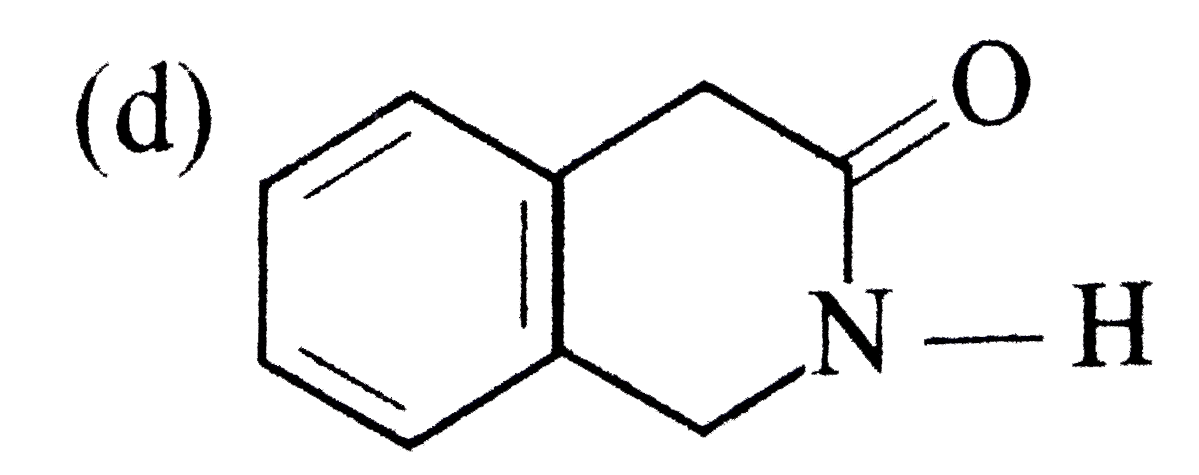Which of the following compound is the strongest base?




The correct Answer is:A
To determine which of the given compounds is the strongest base, we need to analyze the structures of the compounds and their ability to donate a lone pair of electrons. Here’s a step-by-step solution:
Step 1: Identify the Compounds
Assume we have four compounds labeled A, B, C, and D. We will analyze compounds B, C, and D, as compound A is not considered in the initial analysis.
Step 2: Analyze Compound B
- Structure: Compound B has a lone pair on a nitrogen atom.
- Resonance Effect: The lone pair can participate in resonance with the surrounding structure, which decreases its availability for donation.
- Conclusion: The ability of the lone pair to be donated is reduced due to resonance, making B a weaker base.
Step 3: Analyze Compound C
- Structure: Compound C also has a lone pair on a nitrogen atom.
- Resonance Effect: The lone pair participates in resonance, but only in one part of the ring, which means it is somewhat available for donation.
- Comparison: Since the lone pair is less involved in resonance compared to compound B, compound C is a stronger base than B.
Step 4: Analyze Compound D
- Structure: Compound D has a lone pair on a nitrogen atom, but it is involved in resonance with a carbonyl group (C=O).
- Resonance Effect: The lone pair is somewhat involved in resonance, but not as extensively as in compound B.
- Comparison: The lone pair is less available for donation compared to compound C, making D weaker than C but potentially stronger than B.
Step 5: Compare All Compounds
- B: Weak base due to extensive resonance involvement.
- C: Stronger base than B due to lesser resonance involvement.
- D: Weaker than C but possibly stronger than B due to limited resonance.
Step 6: Determine the Strongest Base
- Based on the analysis, compound C is the strongest base among the three compounds analyzed (B, C, and D) because it has a lone pair that is less involved in resonance compared to B and D.
Final Answer:
The strongest base among the given compounds is Compound C.
---
Assume we have four compounds labeled A, B, C, and D. We will analyze compounds B, C, and D, as compound A is not considered in the initial analysis.
- Structure: Compound B has a lone pair on a nitrogen atom.
- Resonance Effect: The lone pair can participate in resonance with the surrounding structure, which decreases its availability for donation.
- Conclusion: The ability of the lone pair to be donated is reduced due to resonance, making B a weaker base.
- Structure: Compound C also has a lone pair on a nitrogen atom.
- Resonance Effect: The lone pair participates in resonance, but only in one part of the ring, which means it is somewhat available for donation.
- Comparison: Since the lone pair is less involved in resonance compared to compound B, compound C is a stronger base than B.
- Structure: Compound D has a lone pair on a nitrogen atom, but it is involved in resonance with a carbonyl group (C=O).
- Resonance Effect: The lone pair is somewhat involved in resonance, but not as extensively as in compound B.
- Comparison: The lone pair is less available for donation compared to compound C, making D weaker than C but potentially stronger than B.
- B: Weak base due to extensive resonance involvement.
- C: Stronger base than B due to lesser resonance involvement.
- D: Weaker than C but possibly stronger than B due to limited resonance.
- Based on the analysis, compound C is the strongest base among the three compounds analyzed (B, C, and D) because it has a lone pair that is less involved in resonance compared to B and D.
The strongest base among the given compounds is Compound C.
Topper's Solved these Questions
- SOME BASIC PRINCIPALS OF ORGANIC CHEMISTRYBOOK - A2ZCHAPTER - SOME BASIC PRINCIPALS OF ORGANIC CHEMISTRYEXERCISE - Bond Fission, Reagents, Reactive Intermediates And Their Stability
31 Videos
- SOME BASIC PRINCIPALS OF ORGANIC CHEMISTRYBOOK - A2ZCHAPTER - SOME BASIC PRINCIPALS OF ORGANIC CHEMISTRYEXERCISE - Structure Isomerism
28 Videos
- SOME BASIC PRINCIPALS OF ORGANIC CHEMISTRYBOOK - A2ZCHAPTER - SOME BASIC PRINCIPALS OF ORGANIC CHEMISTRYEXERCISE - Section D - Chapter End Test
60 Videos
- SOME BASIC CONCEPTS OF CHEMISTRYBOOK - A2ZCHAPTER - SOME BASIC CONCEPTS OF CHEMISTRYEXERCISE - Section D - Chapter End Test
30 Videos
- STATES OF MATTERBOOK - A2ZCHAPTER - STATES OF MATTEREXERCISE - Section D - Chapter End Test
30 Videos
Similar Questions
Knowledge Check
Among the following compounds ,the strongest base is
ANH2−O∣∣C−NH2BNH2−NH∣∣C−NH2CC6H5−NH2DCH3−NH−CH3Which of the following hydroxides is the strongest base?
AB(OH)2BMg(OH)2CCa(OH)2DBa(OH)2For the following compounds, which is the strongest base and which is strongest acid?
 AII = Strongest base, I = Strongest acidBIV=Stronger base, III=Stronger acidCIII = Strongest base, IV = Strongest acidDII = Strongest base, III = Strongest acid
AII = Strongest base, I = Strongest acidBIV=Stronger base, III=Stronger acidCIII = Strongest base, IV = Strongest acidDII = Strongest base, III = Strongest acid
Which of the following is the strongest Bronsted base?
View SolutionWhich of the following is the strongest base in water?
View SolutionWhich one of the following is the strongest base ?
View SolutionWhich of the following is the strongest conjugate base ?
View SolutionAmong the following which is the strongest base :
View Solution
